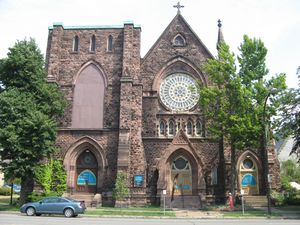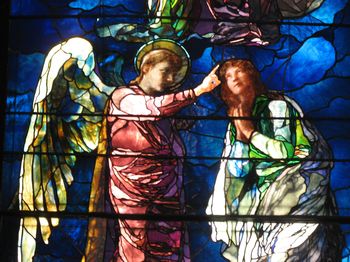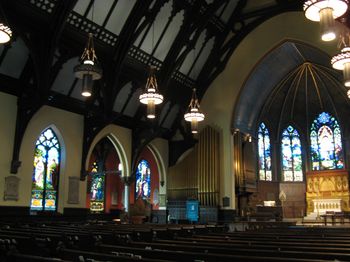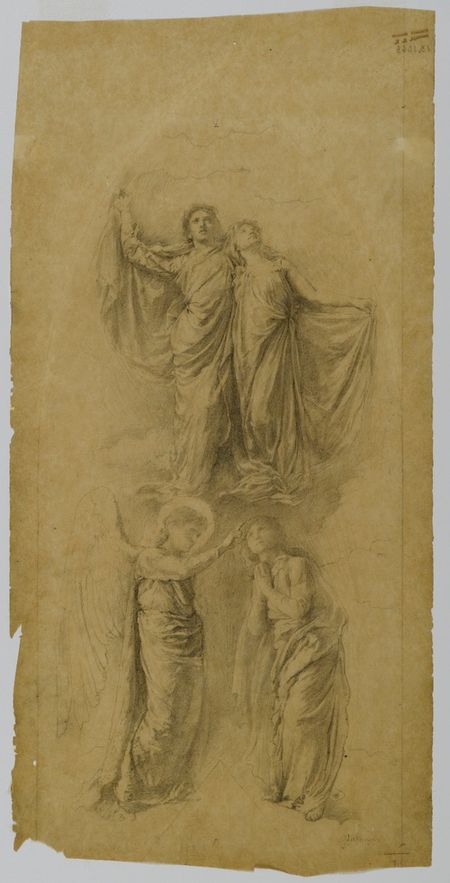On-the-Road Research, or What Curators Do On Their Summer Vacations
One of the projects I’ve been working on is Fine Lines: American Drawings from the Brooklyn Museum, an exhibition of about 100 of our pre-1945 American drawings and sketchbooks scheduled to open in March 2013.

Exterior view of Trinity Church, 371 Delaware Avenue, Buffalo, New York.
At this stage, I’m researching individual objects in preparation for writing the exhibition catalogue. Summer is a great time to conduct research—libraries, historical societies, and other archival institutions are usually air-conditioned! It’s also when many of us get away for a break. This year, I was able to combine work and vacation in Buffalo, New York. Trinity Church, one of this city’s many churches, has a direct connection to a drawing featured in Fine Lines: I had to make a research visit!
This stunning drawing by John La Farge is a preparatory study for a stained-glass window he designed for the church in 1889. The image depicts a scene from the Bible’s Book of Revelation in which an angel (at lower left) places a seal on the forehead of a woman to identify her as one of God’s chosen people, while two other faithful ascend into heaven above. Comparing the two works, you can see that the finished window follows the drawing very closely in composition. Note how, in the drawing, La Farge marked out the window’s architectural borders, including its arched shape and the triangular peak of the altar below. Given how close these works are, it’s interesting to compare how La Farge realized the same design in different media. In the monochromatic drawing, he models the figures and their drapery tonally—varying the shading of the silvery-colored graphite in order to create the illusion of three-dimensional forms. He achieves these same effects in the window through individual pieces of colored glass (with the exception of the hands and faces which are painted).

Detail of Preparatory Study for “The Sealing of the Twelve Tribes”
As these works demonstrate, La Farge was highly talented in many different art forms. Trained as a painter, he turned to decorative work—particularly stained glass and mural painting—in the 1870s. His first major project, Trinity Church in Boston (1876), brought him widespread acclaim. La Farge revolutionized the centuries-old practice of stained glass with several important innovations, including the use of opalescent glass (milky glass with variegations of colors) and the layering of sheets of glass to achieve greater depth and subtleties of color—both evident in the Buffalo window. He developed these techniques in the late 1870s-early 1880s around the same time as Louis Comfort Tiffany, another modern master of stained glass, was making similar experiments. (La Farge received a patent for opalescent glass shortly before Tiffany did.) These two artists set new standards of artistry for the medium, although competition between them turned the former friends into rivals. The Sealing of the Twelve Tribes window helped to bring such advances to international audiences. Before it was installed in Buffalo, La Farge exhibited it at the 1889 Exposition Universale in Paris. The French government awarded him a Cross of the Legion of Honor for the window’s technical originality.

View of interior of Trinity Church; main altar at right, La Farge’s “The Sealing of the Twelve Tribes” window is left of center.
When Trinity Church completed construction on its current building in 1886, its wealthy congregants sought out the best designers to decorate its windows. As a result, it has some of the finest stained glass in America. Of the over twenty windows that bathe the interior with richly colored, luminous light, La Farge made ten and Tiffany five. Charlotte Sherman Watson, a member of a prominent Buffalo banking family, commissioned The Sealing of the Twelve Tribes in memory of her mother and aunt. You can learn more about Trinity Church and its windows at http://buffaloah.com/a/del/389/hp/hp.html.
Seeing the window in situ was a real treat—if you travel to Buffalo, I highly recommend putting this church on your itinerary! My visit also helped me to better understand our beautiful La Farge drawing through learning about its historical context. Keep an eye on the Museum’s website for more information on the Fine Lines exhibition of American drawings.

Karen Sherry joined the Museum in 2003 as project coordinator for the Luce Center for American Art’s Visible Storage ▪ Study Center, a publicly accessible storage facility containing more than 2,000 works of art. In her current position since 2005, she has organized several special exhibitions from the Museum’s renowned collections of American art, including shows on plein-air sketching, Japonisme in American graphic arts, Francis Guy’s early Brooklyn scenes, and, with Teresa Carbone, American landscape watercolors. Prior to coming to the Museum, Ms. Sherry worked as a research assistant at the Metropolitan Museum of Art and Brandywine River Museum, and as co-curator of an exhibition on John Sloan’s graphic works at the Delaware Art Museum. She has also taught art history at Pratt Institute, University of Delaware, and Pennsylvania Academy of the Fine Arts. She earned a B.A. degree from Boston University and an M.A. from University of Delaware, where she is currently completing her Ph.D. Among the honors she has received are fellowships from the Metropolitan Museum of Art, Smithsonian American Art Museum, and Winterthur Museum.

